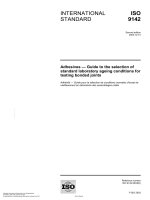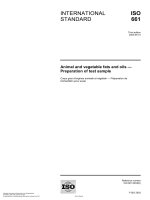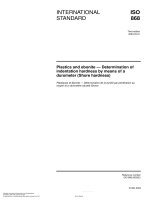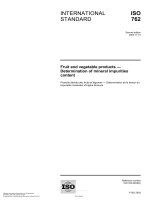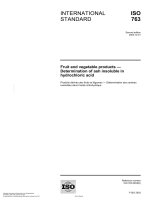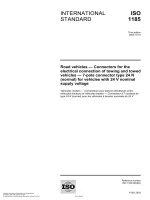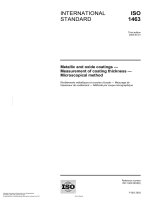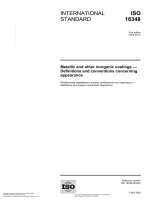Tiêu chuẩn iso 15732 2003
Bạn đang xem bản rút gọn của tài liệu. Xem và tải ngay bản đầy đủ của tài liệu tại đây (293.52 KB, 26 trang )
INTERNATIONAL
STANDARD
ISO
15732
First edition
2003-09-01
Fine ceramics (advanced ceramics,
advanced technical ceramics) — Test
method for fracture toughness of
monolithic ceramics at room temperature
by single edge precracked beam (SEPB)
method
Céramiques techniques — Méthode d'essai de ténacité à la rupture des
céramiques monolithiques à température ambiante sur éprouvette
préfissurée sur une seule face (méthode SEPB)
--`,,,`-`-`,,`,,`,`,,`---
Reference number
ISO 15732:2003(E)
Copyright International Organization for Standardization
Provided by IHS under license with ISO
No reproduction or networking permitted without license from IHS
© ISO 2003
Not for Resale
ISO 15732:2003(E)
PDF disclaimer
This PDF file may contain embedded typefaces. In accordance with Adobe's licensing policy, this file may be printed or viewed but
shall not be edited unless the typefaces which are embedded are licensed to and installed on the computer performing the editing. In
downloading this file, parties accept therein the responsibility of not infringing Adobe's licensing policy. The ISO Central Secretariat
accepts no liability in this area.
--`,,,`-`-`,,`,,`,`,,`---
Adobe is a trademark of Adobe Systems Incorporated.
Details of the software products used to create this PDF file can be found in the General Info relative to the file; the PDF-creation
parameters were optimized for printing. Every care has been taken to ensure that the file is suitable for use by ISO member bodies. In
the unlikely event that a problem relating to it is found, please inform the Central Secretariat at the address given below.
© ISO 2003
All rights reserved. Unless otherwise specified, no part of this publication may be reproduced or utilized in any form or by any means,
electronic or mechanical, including photocopying and microfilm, without permission in writing from either ISO at the address below or
ISO's member body in the country of the requester.
ISO copyright office
Case postale 56 • CH-1211 Geneva 20
Tel. + 41 22 749 01 11
Fax + 41 22 749 09 47
Web www.iso.org
Published in Switzerland
ii
Copyright International Organization for Standardization
Provided by IHS under license with ISO
No reproduction or networking permitted without license from IHS
© ISO 2003 — All rights reserved
Not for Resale
ISO 15732:2003(E)
Contents
Page
Foreword ............................................................................................................................................................ iv
1
Scope...................................................................................................................................................... 1
2
Normative references ........................................................................................................................... 1
3
Terms and definitions........................................................................................................................... 2
4
Symbols and designations................................................................................................................... 3
5
Principle ................................................................................................................................................. 3
6
Apparatus............................................................................................................................................... 4
7
Test specimens ..................................................................................................................................... 7
8
Test methods......................................................................................................................................... 8
9
Evaluation of validity of measured value ......................................................................................... 13
10
Calculation ........................................................................................................................................... 14
11
Test report............................................................................................................................................ 15
Annex A (informative) Precracking fixture..................................................................................................... 16
Annex B (informative) Recommended procedures in SEPB method.......................................................... 18
Bibliography ..................................................................................................................................................... 21
--`,,,`-`-`,,`,,`,`,,`---
iii
© ISO 2003 — All rights reserved
Copyright International Organization for Standardization
Provided by IHS under license with ISO
No reproduction or networking permitted without license from IHS
Not for Resale
ISO 15732:2003(E)
Foreword
ISO (the International Organization for Standardization) is a worldwide federation of national standards bodies
(ISO member bodies). The work of preparing International Standards is normally carried out through ISO
technical committees. Each member body interested in a subject for which a technical committee has been
established has the right to be represented on that committee. International organizations, governmental and
non-governmental, in liaison with ISO, also take part in the work. ISO collaborates closely with the
International Electrotechnical Commission (IEC) on all matters of electrotechnical standardization.
International Standards are drafted in accordance with the rules given in the ISO/IEC Directives, Part 2.
The main task of technical committees is to prepare International Standards. Draft International Standards
adopted by the technical committees are circulated to the member bodies for voting. Publication as an
International Standard requires approval by at least 75 % of the member bodies casting a vote.
Attention is drawn to the possibility that some of the elements of this document may be the subject of patent
rights. ISO shall not be held responsible for identifying any or all such patent rights.
ISO 15732 was prepared by Technical Committee ISO/TC 206, Fine ceramics.
iv
Copyright International Organization for Standardization
Provided by IHS under license with ISO
No reproduction or networking permitted without license from IHS
--`,,,`-`-`,,`,,`,`,,`---
Not for Resale
© ISO 2003 — All rights reserved
INTERNATIONAL STANDARD
ISO 15732:2003(E)
Fine ceramics (advanced ceramics, advanced technical
ceramics) — Test method for fracture toughness of monolithic
ceramics at room temperature by single edge precracked beam
(SEPB) method
1
Scope
This International Standard describes a test method for the determination of fracture toughness of monolithic
ceramic materials at room temperature by the Single Edge Precracked Beam (SEPB) method.
This International Standard is for material development, material comparison, quality assurance,
characterization, reliability and design data generation.
Fracture toughness values determined with other test methods cannot be interchanged with KIpb as defined in
this International Standard, and may not be interchangeable with each other.
Values expressed in this International Standard are in accordance with the International System of Units (SI).
2
Normative references
The following referenced documents are indispensable for the application of this document. For dated
references, only the edition cited applies. For undated references, the latest edition of the referenced
document (including any amendments) applies.
ISO 1101:1983, Technical drawings — Geometrical tolerancing — Tolerancing of form, orientation, location
and run-out — Generalities, definitions, symbols, indications on drawings
ISO 3312:1987, Sintered metal materials and hardmetals — Determination of Young modulus
ISO 4287:1997, Geometrical Product Specifications (GPS) — Surface texture: Profile method — Terms,
definitions and surface texture parameters
ISO 6507-1:1997, Metallic materials — Vickers hardness test — Part 1: Test method
1
© ISO 2003 — All rights reserved
Copyright International Organization for Standardization
Provided by IHS under license with ISO
No reproduction or networking permitted without license from IHS
Not for Resale
--`,,,`-`-`,,`,,`,`,,`---
This International Standard is intended for use with monolithic ceramics and whisker- or particulate-reinforced
ceramics which are regarded as macroscopically homogeneous. It does not include continuous-fiberreinforced ceramic composites.
ISO 15732:2003(E)
3
Terms and definitions
For the purpose of this document, the following terms and definitions apply.
3.1
stress intensity factor
KI
magnitude of the elastic stress field singularity at the tip of a crack subjected to opening mode displacement
NOTE
It is a function of applied force and test specimen size, geometry and crack length, and has the dimensions of
force times length−3/2.
3.2
fracture toughness
generic term for the magnitude of resistance to crack extension
3.3
fracture toughness value
KIpb
fracture toughness value measured by the SEPB method
NOTE
This represents the measured stress intensity factor corresponding to the extension resistance of a straightthrough pop-in crack formed via bridge loading of a Vickers indent or a saw notch. The measurement is performed in
accordance with the operational procedure described in Clauses 5 and 10 and satisfies all the validity requirements.
3.4
precrack
crack induced artificially into a specimen, primarily so as to measure the fracture toughness
3.5
precrack front line
line to indicate the position of the tip of the precrack
3.6
pop-in
phenomenon where a crack arrests after sudden and unstable growth giving rise to an acoustic signature
3.7
three-point bending
loading configuration where a beam specimen is loaded at a location midway between two support pins
3.9
compliance
reciprocal of the gradient of the load versus deflection curve
NOTE
Accordingly, as the crack extends, the increase of deflection results in an increase of compliance.
2
Copyright International Organization for Standardization
Provided by IHS under license with ISO
No reproduction or networking permitted without license from IHS
© ISO 2003 — All rights reserved
Not for Resale
--`,,,`-`-`,,`,,`,`,,`---
3.8
four-point bending
loading configuration where a beam specimen is symmetrically loaded at two locations that are situated one
quarter of the overall span away from the outer two support pins
ISO 15732:2003(E)
4
Symbols and designations
The symbols used throughout this International Standard and their designations are given in Table 1.
Table 1 — Symbols and designations
Symbol
Unit
b
mm
Width of central groove in anvil
d
mm
Thickness of specimen
7.1, Fig. 3
d1
mm
Distance between supporting roller pins in bend test fixture (lower
span)
6.4, Fig. 2
d2
mm
Distance between loading roller pins in four-point bend test fixture
(upper span)
6.4, Fig. 2
KIpb
5
Designation
References
A.2.3, Fig. A.1
MPa⋅m1/2 Critical stress intensity factor measured by the SEPB method
Clause 10, Eqs. 7 and 10
l
mm
Length of precrack
8.7.3, Fig. 6, Eq. 2
∆l
mm
Stable crack growth length
8.7.4, Fig. 6, Eq. 3
L
mm
Length of specimen
La
mm
Length of bottom surface of specimen positioning groove of anvil
(including the width, b, of central groove)
A.2.3, Fig. A.1
Lp
mm
Length of lower surface of loading plate
A.2.3, Fig. A.1
Pf
N
w
mm
λ∆l / λl
1
7.1, Fig. 3
Maximum load during fracture of specimen
8.5.3, Fig. 5
Width (depth) of specimen
7.1, Fig. 3
Compliance change
8.6, Eq. 1
Principle
--`,,,`-`-`,,`,,`,`,,`---
This method is to obtain the fracture toughness value, KIpb, from the precrack length, specimen dimensions
and distance between the bending supports by measuring the fracture load of specimen according to the
three or four-point bending fracture test of a single-edge-precracked beam specimen. A straight-through popin precrack is induced in the specimen via bridge loading of a Vickers indent or a saw notch. Generally, this
test is carried out under conditions of ambient temperature and environment.
3
© ISO 2003 — All rights reserved
Copyright International Organization for Standardization
Provided by IHS under license with ISO
No reproduction or networking permitted without license from IHS
Not for Resale
ISO 15732:2003(E)
6
Apparatus
6.1
Precracking fixture
An appropriate apparatus is required to induce a pop-in precrack in the specimen in such a way that the crack
front is approximately parallel to the specimen surface.
An example of the basic components of the bridge compression precracking fixture are a loading plate with a
ball seat, an anvil with a central groove and a specimen-positioning groove, and a loading ball as shown in
Figure 1. The shapes of the loading plate and the anvil to be used are symmetric from right to left, and from
front to rear, and have depth exceeding at least three times the thickness of the specimen, d. The horizontal
distance between the centre of the loading ball and the centre of the anvil is less than 0,1 mm.
NOTE
Annex A contains recommendations for the typical design of a suitable bridge compression fixture that has
been found to work satisfactorily for most types of ceramic materials.
--`,,,`-`-`,,`,,`,`,,`---
Key
5
lower loading plate; e.g., of silicon nitride with mirror
polished lower surface (joined to upper loading plate)
1
compression load
2
3
loading ball
loading plate
6
7
specimen
central groove
4
upper loading plate; e.g., of hardened steel with ball
seat
8
specimen positioning groove
9
anvil; e.g., of hardened steel (HV 10 > 5 GPa)
Figure 1 — Example of bridge compression precracking fixture
4
Copyright International Organization for Standardization
Provided by IHS under license with ISO
No reproduction or networking permitted without license from IHS
© ISO 2003 — All rights reserved
Not for Resale
ISO 15732:2003(E)
6.2 Precrack introduction loading apparatus
The loading apparatus shall be capable of smoothly applying the compression load to the fixture. High load
accuracy is not required.
6.3 Bend testing machine
A material testing machine capable of maintaining the cross-head-speed constant shall be used. The
accuracy of load measurement shall be ± 1 % over the entire range of load.
The rigidity of the entire testing system, including the bending test fixture specified in 6.4, shall be 3 MN/m or
more against the load applied to the bending test fixture.
The rigidity of the entire testing system, including the testing machine, loading rods and bending test fixture,
should be evaluated in accordance with Annex B.
6.4
Bend test fixture
The general features of the bend test fixtures are illustrated in Figure 2. The bend test fixture shall be
symmetrical about the centre line shown and have a depth exceeding at least three times the thickness, d, of
the specimen to be used. The fixture is designed to minimize frictional effects by allowing the support roller to
roll apart slightly as the specimen is loaded, thus permitting rolling contact and avoiding frictional wedging of
the specimen.
The roller pins are placed in the positioning grooves of the support member and of the loading member as
shown in Figure 2. The rollers shall be parallel to each other to within 0,015 mm over a length equal to the
specimen thickness, d. Other types of fixtures are acceptable, however, roller pins shall be free to roll. The
length of each roller pin shall be equal to at least three times the specimen thickness. Materials composing
the parts of the roller pins to be used shall have a modulus of elasticity not less than 196 GPa, as defined in
ISO 3312 and a hardness of not less than 5 GPa Vickers (HV10) as defined in ISO 6507-1, and made of a
material free from plastic deformation and risk of fracture. The radius of curvature of rollers and the distance
between the rollers shall be as shown in Figure 2. The surface roughness of the rollers, Ra, as defined in
ISO 4287 shall be not more than 0,4 µm.
--`,,,`-`-`,,`,,`,`,,`---
6.5 Compliance change measuring device
At the time of the bend test, the relation between the deflection of the test specimen and the load shall be
measured by using the deflection meter which can measure the load point deflection between the centre of
two supporting roller pins of the bend test fixtures and the centre of loading roller pin(s). The deflection
measuring device shall have a resolution greater than 0,001 mm, and shall be calibrated to read within
0,001 mm of the true displacement. Measurements of displacement shall be made to a precision of 0,001 mm.
6.6
Measuring instruments
Three fundamental measurements are necessary for the calculation of KIpb, namely, the width, w, the
thickness, d, and the precrack length, l.
Measuring devices such as micrometers or other devices having an accuracy of at least 0,01 mm shall be
used for measuring the linear dimensions.
5
© ISO 2003 — All rights reserved
Copyright International Organization for Standardization
Provided by IHS under license with ISO
No reproduction or networking permitted without license from IHS
Not for Resale
ISO 15732:2003(E)
--`,,,`-`-`,,`,,`,`,,`---
Key
1
2
3
4
specimen (I or II)
loading ball
loading member
5
6
precrack
supporting roller pins
loading roller pin
7
support member
a) Three-point bend test fixture
Key
4
specimen (II or III)
1
2
loading ball
loading member
5
6
precrack
supporting roller pins
3
loading roller pins
7
support member
b) Four-point bend test fixture
6
Copyright International Organization for Standardization
Provided by IHS under license with ISO
No reproduction or networking permitted without license from IHS
© ISO 2003 — All rights reserved
Not for Resale
ISO 15732:2003(E)
Dimensions in millimetres
Bending mode
Specimen
Diameters of
roller pins
d1 (lower span)
d2 (upper span)
3-point bend
I
4,0 to 5,0
16 ± 0,2
–
3-point bend
II
4,0 to 5,0
30 ± 0,3
–
4-point bend
II
4,0 to 5,0
30 ± 0,3
10 ± 0,2
4-point bend
III
4,0 to 5,0
40 ± 0,4
20 ± 0,2
Figure 2 — Bend test fixtures
7
7.1
Test specimens
Shape and dimensions of specimen, and chamfering of edge
The shape of the specimens shall be that of a rectangular beam and its dimensions shall be as shown in
Figure 3. Sampling position and orientation of specimen removal from raw material shall be recorded.
The opposing faces of the specimen shall be parallel to each other and the faces shall intersect
perpendicularly. The maximum variation in parallelism and perpendicularity shall not exceed 0,01 mm as
defined in ISO 1101.
Dimensions in millimetres
Specimen
Total length, L
Width, w
Thickness, d
Chamfering, C
I
W 18
4 ± 0,1
3 ± 0,1
0,12 ± 0,03
II
W 36
4 ± 0,1
3 ± 0,1
0,12 ± 0,03
III
W 45
4 ± 0,1
3 ± 0,1
0,12 ± 0,03
--`,,,`-`-`,,`,,`,`,,`---
Further, the four long edges of each specimen shall be chamfered uniformly at 45° ± 5°.The chamfered edge
length shall be 0,12 mm ± 0,03 mm, as shown in Figure 3 (hereafter, a specimen of 18 mm or more in length
is referred to as “specimen I”, a specimen of 36 mm or more in length, as “specimen II”, and a specimen of
45 mm or more in length, as “specimen III”).
Figure 3 — Dimensions of specimen
7.2
Surface roughness of upper and lower surfaces and both side surfaces of specimen
The surface roughness of the four surfaces of the specimen, Ra, as defined in ISO 4287 excluding both end
surfaces in the length direction shall be not more than 0,2 àm.
7
â ISO 2003 All rights reserved
Copyright International Organization for Standardization
Provided by IHS under license with ISO
No reproduction or networking permitted without license from IHS
Not for Resale
ISO 15732:2003(E)
7.3
Number of specimens
--`,,,`-`-`,,`,,`,`,,`---
The number of specimens shall be not less than five pieces. All specimens shall comply with the specification
given in 9.1.
8
Test methods
8.1
Measurement of thickness and width of specimen
The measurement of thickness and width of specimen shall be carried out using a micrometer or other device
accurate to the nearest 0,01 mm.
8.2
Introduction of precrack starter
8.2.1
General
As the precrack generating start point, a Vickers indentation (or Knoop indentation) or notch near the middle
of the d × L surface of the specimen in a direction within 2° of the normal direction to the w × L surface shall
be induced according to the schematic diagram in Figure 4. The recommended conditions for introduction of
the precrack starter are given in 8.2.2 and 8.2.3.
NOTE
The position of the precrack starter in the lengthwise direction is not specified, but the positioning is important
for precrack introduction (see Annex B).
8.2.2
8.2.2.1
The use of Vickers indentation (or Knoop indentation)
Position of indentation
One point shall be at the middle of the d × L plane of the specimen. Additional points shall be placed
symmetrically on both sides of the first indent.
8.2.2.2
Direction of indentation
The diagonal line of the Vickers indentation (or major axis of Knoop indentation) shall intersect
perpendicularly the lengthwise direction of specimen.
8.2.2.3
Indentation load
Select an indentation force adequate to produce straight cracks from the corners of the indentation without
causing extensive ancillary damage.
An indentation force of 98 N (or 100 N) is adequate to induce a starter crack in most materials. If this force
produces excessive damage, e.g. in relative soft or brittle materials, use a lower force. If precracking using an
indentation prepared using a force of 98 N (or 100 N) is unreliable, increase the number of adjoining
indentations across the specimen width rather than increasing the force. However, where introduction of a
precrack is impossible, the notch method may be used.
8.2.3
8.2.3.1
The use of a straight-through saw notch
Width of notch
The width of the notch shall be not more than 0,1 mm. The shape of the tip of the notch is not specified.
8
Copyright International Organization for Standardization
Provided by IHS under license with ISO
No reproduction or networking permitted without license from IHS
© ISO 2003 — All rights reserved
Not for Resale
ISO 15732:2003(E)
8.2.3.2
Depth of notch
The depth of the notch shall not exceed 0,6 mm and be 0,4 mm ± 0,2 mm.
NOTE
If a notch depth exceeding 0,6 mm is used, stable crack growth, instead of pop-in, may occur from the notch
tip during precrack introduction. Fracture toughness values measured from the stably grown precrack might be greater
than the fracture toughness measured under this procedure.
Dimensions in millimetres
Key
1
specimen
2
3
Vickers (or Knoop) indentation(s)
notch
Figure 4 — Introduction of Vickers indentation or notch
8.3
Introduction of precrack
NOTE
A recommended precracking fixture is shown in detail in the Annex A. A recommended procedure for precrack
introduction is shown in detail in the Annex B.
8.3.2 Sufficiently clean the specimen, the bottom surface of specimen positioning groove of the precracking
anvil and the lower surface of loading plate by wiping off any oil and stains using acetone. Place the specimen
in the specimen positioning groove of the anvil as shown in Figure 1, taking care to arrange the specimen so
that the lengthwise direction of the specimen intersects perpendicularly the central groove of the anvil, and the
precrack starter positions in the range of ± 0,1 mm from the centre of the central groove.
9
© ISO 2003 — All rights reserved
Copyright International Organization for Standardization
Provided by IHS under license with ISO
No reproduction or networking permitted without license from IHS
Not for Resale
--`,,,`-`-`,,`,,`,`,,`---
8.3.1 Arrange the specimen with the previously induced precrack starter, between the loading plate of the
precrack inducing fixture and the anvil as shown in Figure 1. Introduce an unstably grown pop-in crack. The
d × L surface contacts with the loading plate and the specimen positioning groove of the anvil. The procedure
is given in 8.3.2 to 8.3.5.
ISO 15732:2003(E)
8.3.3 Place the loading plate on the specimen, making sure that the specimen does not slide. The loading
plate and the anvil shall be arranged symmetrically.
8.3.4 Using the loading ball and anvil, increase the compression load vertically to the loading plate. Stop
loading immediately after the pop-in sound is detected, because an excessive compression load may damage
the fixtures and cause uneven development of precrack. The speed at which to apply a compression load is
recommended to be in the range 300 N/s to 1 000 N/s.
NOTE 1
For materials with a rising R-curve the measured fracture toughness value might be artificially high if stable
crack growth occurs after pop-in.
NOTE 2
Sonic sensors, e.g. an acoustic emission sensor or a stethoscope, are useful for detecting the pop-in during
precracking. See Annex B.
8.3.5 Remove the specimen from the fixture and confirm that the precrack has been induced on both side
surfaces. If the precrack is difficult to locate, a dye penetrant, e.g. oil based paint mixed with acetone, may be
used to improve visibility. If a dye penetrant is used, the following bend test shall be carried out after complete
drying of the dye penetrant.
8.4
Test atmosphere
The bend test is carried out under conditions of ambient temperature and environment. If susceptibility to
environmental degradation, such as slow crack growth during the bend test, is a concern, environmental
effects shall be evaluated by measuring both the compliance change and the stable crack growth length
specified in 8.6 and 8.7. The permissible range of the compliance change and the stable crack growth length
in order to evaluate the valid fracture toughness value, are specified in 9.2.
In many ceramics, including most oxides, moisture in the atmosphere can have a marked effect in enhancing
crack propagation characteristics, and hence in reducing the measured toughness. Environment conditions,
such as relative humidity and temperature, shall be reported. A dry atmosphere, such as dry air, nitrogen or
argon with a purity of 99,9 % or better at atmospheric pressure, or vacuum of less than 0,13 Pa, removes most of
the effects of moisture.
8.5
8.5.1
Three- or four-point bending fracture test
General
Arrange the precracked specimen within the bend test device as shown in Figure 2. Ensure that the d × L
surface of the specimen makes contact with the supporting roller pins, and that the roller pins are in the
correct starting position. The procedures are described in 8.5.2 and 8.5.3.
8.5.2
Arrangement of specimen
Ensure the specimen is dry. Arrange the specimen so that the roller pins lie with their axes within 2°
perpendicular to the length of the specimen. The distance between the position of precrack starter and the
dead centre of the loading pin(s) shown in Figure 2 shall be within 1 % of the lower span length, d1.
8.5.3
Bending fracture test
8.6
Measurement of compliance change
Generally, a compliance change in a load versus load point deflection curve during a flexural test is not
observed for common monolithic ceramics. However, if observed, the validity of measured fracture toughness
values shall be evaluated. In this international Standard, the validity is evaluated from the movement of the
pop-in precrack front line before final fracture.
10
Copyright International Organization for Standardization
Provided by IHS under license with ISO
No reproduction or networking permitted without license from IHS
© ISO 2003 — All rights reserved
Not for Resale
--`,,,`-`-`,,`,,`,`,,`---
Apply a compressive load to the loading pin(s) at a cross-head speed of 0,5 mm/min until the specimen
fractures, and measure the maximum load, Pf, to an accuracy of ± 1 % and the compliance change as
specified in 8.6. The time to failure should not exceed 20 s in order to avoid environmental effects.
ISO 15732:2003(E)
Measure the load point deflection between the centre of two supporting roller pins of the bend test fixture and
the loading pin(s), using a suitable deflection meter. Follow the procedure shown in Figure 5 to measure the
compliance change λ∆l / λ l. The minimum reading in this case shall be 0,001 mm, or the accuracy shall be
equivalent to or better than this. When the deflection is measured, it shall not adversely affect the
measurement of fracture load of test specimen. Use the following equation to obtain λ∆l / λ l . That value shall
be the compliance change.
y ∆l
λ∆l y∆l / Pf
=
=
yl / Pf
yl
λl
(1)
where
Pf
is the maximum load before fracture in newtons;
yl
is the deflection where the extension line of load line reaches Pf, in millimetres;
y ∆l is a value obtained by subtracting yl from deflection at the time of fracture, in millimetres.
--`,,,`-`-`,,`,,`,`,,`---
y ∆l
λ∆l y ∆l / Pf
=
=
u 0,1 l /w
yl / Pf
yl
λl
Figure 5 — Load versus load point deflection curve and compliance change at bend test
8.7
Measurement of precrack length and stable crack growth length
8.7.1 Enlarge the fracture surface of the fractured specimen by at least × 20 using a microscope or by
photography, and measure the length of precrack to the nearest 0,01 mm. If stable crack growth of a different
pattern is observed between the precracked region and the unstable crack growth region on the fracture
surface, measure the stable crack growth length in the same way. The measurement of precrack length and
stable crack growth length, and procedures of calculation, are given in 8.7.2 to 8.7.4.
A calibration of micrograph system shall be prepared from the measurement of the known specimen width in
order to determine the true magnification used for the fracture surface.
NOTE
The stable crack growth region is generally observed on the fracture surface by having different light reflection
or a different colour (generally whitish).
11
© ISO 2003 — All rights reserved
Copyright International Organization for Standardization
Provided by IHS under license with ISO
No reproduction or networking permitted without license from IHS
Not for Resale
ISO 15732:2003(E)
8.7.2 As shown in Figure 6, the distance from the lower surface of the specimen to the front line of the
precrack in the specimen width, w, direction is determined by measuring the lengths of l 1, l 2 , l 3 , ∆l 1, ∆l 2 and
∆l 3 on the three lines which divide into four equal parts the thickness, d, of the specimen. In the case where
the front line of the precrack cannot be judged from the fracture surface profile, consider the front line of the
dyed region to be the front line of precrack.
8.7.3 Obtain the average value of each measured value according to the following formula and take it as
the precrack length.
l +l +l
l= 1 2 3
3
(2)
where l1, l2 and l3 are measured pop-in crack lengths in millimetres.
Thus l is the average precrack length in millimetres.
8.7.4 Obtain the average value of each measured value, ∆l 1, ∆l 2 and ∆l 3 in accordance with the following
formula and take it as the stable crack growth length.
∆l =
∆l 1 + ∆ l 2 + ∆ l 3
3
(3)
where ∆l 1, ∆l 2 and ∆l 3 are measured stable crack growth lengths in millimetres.
Thus ∆l is average stable crack growth length in millimetres.
--`,,,`-`-`,,`,,`,`,,`---
Key
1
2
fracture surface of specimen
stable growth crack front line
5
6
Vickers impression(s)
unstable crack growth region
3
4
precrack front line
notch
7
8
stable crack growth region
pop-in crack growth region
Figure 6 — Measurement of length of precrack and stable crack growth
12
Copyright International Organization for Standardization
Provided by IHS under license with ISO
No reproduction or networking permitted without license from IHS
© ISO 2003 — All rights reserved
Not for Resale
ISO 15732:2003(E)
9
Evaluation of validity of measured value
9.1
Specifications of precrack dimensions and shape
9.1.1
General
The tolerance ranges of inclination, oblique advance, and length of front line of the precrack are specified as
follows. Results are acceptable only for specimens which comply with all of the specifications given in 9.1.2 to
9.1.4. The result obtained from unacceptable test specimen shall be recorded only for informative reference
value.
9.1.2
Permissible range of inclination of precrack front line
The difference between maximum and minimum measured values of l shall be no greater than 10 % of the
average precrack length, l. See Equation (4).
l max − l min
u 0,1
l
(4)
where
lmax is the maximum measured value in l1, l2 and l3;
lmin is the minimum measured value in l1, l2 and l3.
9.1.3
Permissible range of precrack oblique advance
As shown in Figure 7, the advancing route of the precrack at the lower surface and both side surfaces of the
specimen shall be not more than 5° from the surface normal to the thickness direction and width direction of
the specimen for the 3-point bend specimen and not more than 10° for the 4-point bend specimen.
NOTE
Acceptance or rejection of the result for a test piece, resulting from an angle crack may be determined most
simply by using a microscope with a rotary stage, viewing the side face of the test piece, aligning a cross-wire first with the
test piece edge, and then with the average line of the crack from its tip, in both cases reading the angular scale on the
microscope stage to the nearest 0,5°. From the angle difference the crack misalignment angle may be computed taking
into account twist.
Key
1
2
specimen
precrack
a
5° max. for the 3-point bend specimen; 10 max. for the 4-point bend specimen.
o
Figure 7 — Permissible range of oblique advance of precrack
--`,,,`-`-`,,`,,`,`,,`---
13
© ISO 2003 — All rights reserved
Copyright International Organization for Standardization
Provided by IHS under license with ISO
No reproduction or networking permitted without license from IHS
Not for Resale
ISO 15732:2003(E)
9.1.4
Permissible range of precrack length
The precrack length shall be in the range of 0,35 u l/w u 0,6.
9.2
Provision for stable crack growth
--`,,,`-`-`,,`,,`,`,,`---
9.2.1
General
The permissible range of the stable crack growth length and the compliance change shall be specified in 9.2.2
and 9.2.3 respectively. In principle, a test specimen which has passed all these provisions and the provision
laid down in 9.1 shall be deemed as giving an acceptable result. The results obtained from unacceptable test
specimens shall be recorded only for informative reference value.
9.2.2
Permissible range of stable crack growth length
The stable crack growth length, ∆l, shall be within the range of 2 % of the precrack length, l.
∆l u 0,02l
9.2.3
(5)
Permissible range of compliance change
The compliance change, λ∆l / λ l, shall be within the range of 10 % of the ratio of precrack length, l, to the
depth of test specimen, w.
λ ∆l
l
u 0,1
λl
w
(6)
10 Calculation
Calculate the fracture toughness value, KIpb (critical stress intensity factor in mode I), in units of megapascal
metres to the power half from the measured values for each specimen according to the following formulae.
Obtain the average value of fracture toughness of five or more specimens complying with the specification
given in 9.1 and 9.2 and round off to one decimal place.
K Ipb =
1/ 2
Pf × d 1 3 l
l
×Y
w
d × w 3 / 2 2 w
(7)
where, in the case of 3-point bend specimen I (applicable range of formula: 0,35 u l/w u 0,6),
1,99 −
l
Y =
w
2
l
l
l
l
1
2,15
3,93
2,7
−
−
+
w
w
w
w
l
l
1+2 w 1 − w
(8)
3/2
In the case of 3-point bend specimen II (applicable range of formula: 0,35 u l/w u 0,6),
2
3
l
l
l
l
l
Y = 1,964 − 2,837 + 13,711 − 23,250 + 24,129
w
w
w
w
w
4
(9)
In the case of 4-point bend specimens II and III (applicable range of formula: 0,35 u l/w u 0,6),
14
Copyright International Organization for Standardization
Provided by IHS under license with ISO
No reproduction or networking permitted without license from IHS
© ISO 2003 — All rights reserved
Not for Resale
ISO 15732:2003(E)
--`,,,`-`-`,,`,,`,`,,`---
1/2
l
Pf ( d 1 − d 2 ) 3 w
l
×
K Ipb =
F
3/2
2
w
d × w 3/2
1 − l
w
(10)
where
2
l
l
l l
3,49 − 0,68 + 1,35 1 −
w
w
w
w
l
l
F = 1,988 7 − 1,326 −
2
w
w
l
1
+
w
(11)
11 Test report
The test report shall include the following information:
a)
type of material, code, batch number, date of manufacture;
b)
type of specimen (either specimen I, specimen II or specimen III);
c)
type of bending mode (either 3-point bend or 4-point bend);
d)
number of specimens complying with the specifications laid down in 9.1 and 9.2;
e)
measured fracture toughness values (critical stress intensity factor in mode I), KIpb, and the average, in
megapascal metres to the power half;
f)
manufacturing process and dimensions, form of raw material as well as sampling position and direction of
specimen;
g)
specimen dimensions: thickness, d, width, w, in millimetres;
h)
precracking conditions (type of precrack starter, width of anvil central groove and pop-in load, etc.);
i)
environment conditions, relative humidity and temperature;
j)
maximum load before fracture, Pf, in newtons;
k)
time to failure, in seconds;
l)
precrack lengths and their average, l, in millimetres;
m) presence or absence of stable crack growth and average of stable crack growth length;
n)
presence or absence of compliance change and the value of compliance change.
15
© ISO 2003 — All rights reserved
Copyright International Organization for Standardization
Provided by IHS under license with ISO
No reproduction or networking permitted without license from IHS
Not for Resale
ISO 15732:2003(E)
--`,,,`-`-`,,`,,`,`,,`---
Annex A
(informative)
Precracking fixture
A.1 Introduction
While there are a number of methods for inducing a straight precrack in a ceramic specimen, the bridge
compression method has been found to be reliable for a number of materials. This Annex provides for
guidance details of typical compression fixture designs, which have been found to operate satisfactory. It
should be noted that whatever the details of the design, the result will depend to some extent on the skill of
the user, and on the precision with which the fixture is made.
NOTE
The recommended techniques relating to the precrack introduction fixture are noted in Annex B.
A.2 Recommended design
A.2.1 The basic components of the precracking fixture are a loading plate with a ball seat, an anvil with
central groove and a loading ball as shown in Figure A.1. The shapes of the loading plate and the anvil to be
used are symmetrical from to right to left, and from front to rear, and have a depth exceeding at least three
times the thickness of the specimen, d. The horizontal distance between the centre of the loading ball and the
centre of the anvil is less than 0,1 mm. The width, b, of the central groove of the anvil should be between
2 mm and 8 mm and should be selected by trial and error so that the precrack length to be induced complies
with the specification laid down in 9.1.
A.2.2 The anvil has a specimen-positioning groove taht is at a right angle to the central groove. The bottom
width of the specimen-positioning groove is larger than the thickness of the specimen, as shown in Figure A.1.
The lower surface of the specimen should closely contact the bottom of the specimen-positioning groove.
A.2.3 In order to avoid stress concentration on the specimen ends, the length, Lp, of the lower surface of the
loading plate and the length, La, of the bottom surface of the specimen-positioning groove of the anvil
(including the width, b, of the central groove) should be shorter than the length of the specimen, L, and are
made identical and equal to 18 mm (± 0,1 mm) which is shortest length in a type III specimen.
NOTE
By using a precracking fixture with a fixed length Lp (= La; u L) the pop-in load in each material is independent
of the specimen types (I, II, III).
A.2.4 Materials composing the parts of the loading ball, the lower surface of the loading plate and bottom
surface of the specimen positioning groove of the anvil in contact with the specimen should have a modulus of
elasticity not less than 196 GPa as defined in ISO 3312 and a hardness of not less than 5 GPa in Vickers
(HV10) as defined in ISO 6507-1, and be free from plastic deformation when the specimen is compressed.
A.2.5 The variation in flatness of the lower surface of the loading plate and of the bottom surface of the
specimen-positioning groove of the anvil should preferably be not more than 0,01 mm as defined in ISO 1101,
and their roughness should preferably be not more than 0,2 µm Ra as defined in ISO 4287. A sintered silicon
nitride plate with a mirror finish and a thickness exceeding 4 mm is recommended for the bottom part of the
loading plate. The upper and lower surfaces of the loading plate, the bottom surface of the specimen
positioning groove and the lower surface of the anvil are parallel to one another. The deviation from
parallelism as defined in ISO 1101 should not exceed 0,02 mm.
A.2.6 As an alternative, the surface of the loading plate in contact with the specimen may be rounded with a
radius of curvature exceeding 3d and an axis lying along the length of the specimen. This arrangement has
been found to improve the reliability of precracking by more closely defining the axis of loading. See [1],[2], [3].
16
Copyright International Organization for Standardization
Provided by IHS under license with ISO
No reproduction or networking permitted without license from IHS
© ISO 2003 — All rights reserved
Not for Resale
